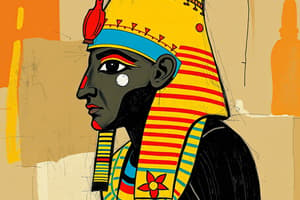Podcast
Questions and Answers
What factors contributed to the economic, political, social, and cultural changes during the period between 700 and 1750?
What factors contributed to the economic, political, social, and cultural changes during the period between 700 and 1750?
- Isolation of different regions
- Stagnation of trade routes
- Decline in agricultural practices
- Emergence of new technologies and crops (correct)
What characteristics were attributed to the Rajputs by their poets and bards?
What characteristics were attributed to the Rajputs by their poets and bards?
- Political savvy and diplomacy
- Extreme valour and loyalty (correct)
- Economic efficiency and wealth
- Artistic talent and creativity
Which group of people claimed Kshatriya caste status and became significant during this period?
Which group of people claimed Kshatriya caste status and became significant during this period?
- Brahmins
- Rajputs (correct)
- Shudras
- Vaishyas
What was one impact of agriculture extension during this period?
What was one impact of agriculture extension during this period?
What role did Kayasthas play during the changes from 700 to 1750?
What role did Kayasthas play during the changes from 700 to 1750?
What was a common reason for the mobility of people during this period?
What was a common reason for the mobility of people during this period?
Which of the following was NOT a new technology introduced during the period between 700 and 1750?
Which of the following was NOT a new technology introduced during the period between 700 and 1750?
What was one consequence of habitat changes experienced by forest-dwellers during this time?
What was one consequence of habitat changes experienced by forest-dwellers during this time?
Why must historians be sensitive to the different historical backgrounds when reading documents?
Why must historians be sensitive to the different historical backgrounds when reading documents?
How did the meaning of the term 'Hindustan' change over time?
How did the meaning of the term 'Hindustan' change over time?
In the medieval period, how was the term 'foreigner' understood differently than today?
In the medieval period, how was the term 'foreigner' understood differently than today?
What is a key challenge historians face with historical terminologies?
What is a key challenge historians face with historical terminologies?
Which statement about the term 'Hindustan' is correct?
Which statement about the term 'Hindustan' is correct?
Which of the following best exemplifies how language evolves in historical context?
Which of the following best exemplifies how language evolves in historical context?
Which of the following statements about historical sources is accurate?
Which of the following statements about historical sources is accurate?
Why is it important for historians to consider the meanings of familiar words over time?
Why is it important for historians to consider the meanings of familiar words over time?
What was a key reason for rulers to claim control over different parts of the subcontinent?
What was a key reason for rulers to claim control over different parts of the subcontinent?
Which language was noted as not belonging to any region according to Amir Khusrau?
Which language was noted as not belonging to any region according to Amir Khusrau?
What significant change occurred by the eighteenth century in the subcontinent?
What significant change occurred by the eighteenth century in the subcontinent?
Which of the following languages did NOT appear in Amir Khusrau's list of regional languages?
Which of the following languages did NOT appear in Amir Khusrau's list of regional languages?
What legacy was left by the empires that ruled over various regions of the subcontinent?
What legacy was left by the empires that ruled over various regions of the subcontinent?
According to Amir Khusrau, who primarily knew the language Sanskrit?
According to Amir Khusrau, who primarily knew the language Sanskrit?
What characteristic did the rulers of the Chola, Khalji, Tughluq, and Mughal empires share?
What characteristic did the rulers of the Chola, Khalji, Tughluq, and Mughal empires share?
What observation can be made about the names of languages mentioned by Amir Khusrau?
What observation can be made about the names of languages mentioned by Amir Khusrau?
What is the primary issue historians face with manuscripts?
What is the primary issue historians face with manuscripts?
What special characteristics does the shikaste style of writing have?
What special characteristics does the shikaste style of writing have?
What is the size classification of the miniature paintings mentioned?
What is the size classification of the miniature paintings mentioned?
Why were miniatures sometimes sold separately from their manuscripts?
Why were miniatures sometimes sold separately from their manuscripts?
What was a common practice among authors of chronicles during the fourteenth century?
What was a common practice among authors of chronicles during the fourteenth century?
What challenge arises from the copying of manuscripts over centuries?
What challenge arises from the copying of manuscripts over centuries?
What typically happened to manuscripts lost in library collections?
What typically happened to manuscripts lost in library collections?
What can be inferred about different manuscript versions being read by historians?
What can be inferred about different manuscript versions being read by historians?
What was a significant social change amongst peasants as societies became more differentiated?
What was a significant social change amongst peasants as societies became more differentiated?
What role did jatis play in the social structure of villages?
What role did jatis play in the social structure of villages?
Which of the following factors contributed to the ranking of people into sub-castes?
Which of the following factors contributed to the ranking of people into sub-castes?
What was the extent of the ruler's empire mentioned in the context?
What was the extent of the ruler's empire mentioned in the context?
What was the role of the jati panchayat?
What was the role of the jati panchayat?
What economic activity did some peasants combine with agriculture during the lean season?
What economic activity did some peasants combine with agriculture during the lean season?
How did the status of individuals in a jati area vary?
How did the status of individuals in a jati area vary?
What is a misconception regarding the claims of the ruler's conquests?
What is a misconception regarding the claims of the ruler's conquests?
Flashcards are hidden until you start studying
Study Notes
Historical Context and Sources
- Historians must be sensitive to the historical context when analyzing past documents and texts
- Language and its meaning change over time
- Medieval Persian is different from modern Persian, including grammatical and vocabulary differences
- The term "Hindustan" has evolved; in the thirteenth century, it referred to Punjab, Haryana, and the lands between the Ganga and Yamuna, but did not include South India.
- The meaning of "Hindustan" broadened to include India’s geography, fauna, and culture by the early sixteenth century
- The term "foreigner" also has a dynamic meaning; in medieval times, it meant someone unfamiliar with a specific place, regardless of their origin.
Manuscript Variations
- Manuscripts from the past have variations due to inconsistencies in copying during the period, making it difficult to ascertain the original author’s intent
- Historians have to compare different manuscript versions to analyze the author’s original writing
Change and Innovation
- The period between 700 and 1750 saw significant technological advancements, including the Persian wheel for irrigation, the spinning wheel in weaving, and the introduction of new crops like potatoes, corn, chillies, tea, and coffee
- These innovations brought new people and ideas to the subcontinent, leading to profound economic, political, social, and cultural transformations
Social Stratification and Emergence of New Groups
- The subcontinent saw significant population movement during this period, as people sought opportunities for wealth and success
- The Rajputs, a warrior group claiming Kshatriya caste status, became prominent during this time, known for their chivalry, valor, and loyalty
- Other groups, such as the Jats and Kayasthas, also gained political importance during this period
- Habitat changes, including forest clearing and expansion of agriculture, led to migration and the emergence of new peasant groups
- These changes led to social differentiation, with people divided into jatis (caste groups) based on occupation and background
- The authority of jatis was exercised by assemblies of elders, known as jati panchayats
Regionalism and Empires
- By the year 700, different regions in the subcontinent had established distinct geographic dimensions, languages, and cultural characteristics
- Different empires, like the Cholas, Khaljis, Tughluqs, and Mughals, rose and fell, creating a pan-regional empires across the subcontinent
- The decline of the Mughal Empire in the eighteenth century led to the emergence of regional states
- These empires left lasting legacies on the regions they ruled, shaping their cultural and political landscape.
Studying That Suits You
Use AI to generate personalized quizzes and flashcards to suit your learning preferences.




